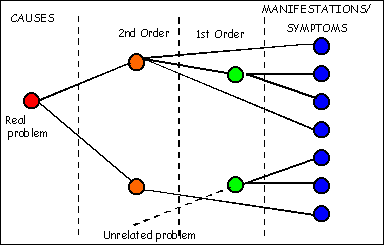
Step 1: Defining the problem situation.
The aim is to understand the reality, sweeping in as many perspectives as possible. Ensure that you:
- Understand the context in which you operate both external and internal.
- Explore how things link together and influence each other.
- Are able to identify who are the key actors who play a role in ensuring that the project is successful. These are the people who initiate and execute the project.
- Be clear who the client is - these are the people who will benefit directly from the project - for example, the workers on the noisy factory floor will be the clients in a hearing conservation project (as compared to the owners of the company who will benefit indirectly from improved productivity).
- Understand what is driving the need to solve the problem. What is the worldview or assumptions we make of the system? As an example of this, we could ask if the need to conserve hearing is simply a legal requirement, or is there a genuine commitment from management regarding the well being of their employees?
- Who are the owners of the process? The easiest way to identify them is to ask who can stop it from happening. (These are the stakeholders).
- What are the environmental constraints? In other words what are the things that are obstacles to the project.
In order to define the problem to be addressed it is important to:
- Clarify terms - ask the actors what the problem is? Let them explain in their own words.
- Identify the manifestations of the problem - these are the symptoms of the problem. For example, high levels of absenteeism may be indicative of an underlying sick building problem.
- Define the causes - look at the manifestations and decide what could be the causes of these manifestations.
- Find the causes of the causes - continue to ask the question "why?" - do this until you are satisfied that you have found the real problem. It is possible to construct a causal tree that starts with the manifestations and through a process of questioning you arte able to elicit the root problem to be addressed. For example the manifestations or symptoms could be the frequency of disabling injuries, the second order cause could be poor worker training at the task generating the injuries, the second order problem could be a line manager that has an attitude against training these workers, and the real cause could be organisational factors that block any serious safety systems in the firm emanating from top management

Avoiding a Type Three Error:
In defining the problem, it is vital that a Type Three error is avoided. A type three error is committed when you develop a perfect solution to the wrong problem. In management a type three error occurs when one fails to identify the correct problem to address. Avoid trying to solve the symptoms - look at what’s causing the problem.
ACTIVITY
Read through the Case Study. Using the information provided, define the problem to be addressed and develop a "problem tree" that best describes the problem. (For the purposes of this exercise you might need to make some assumptions about the situation and use your imagination a bit).


